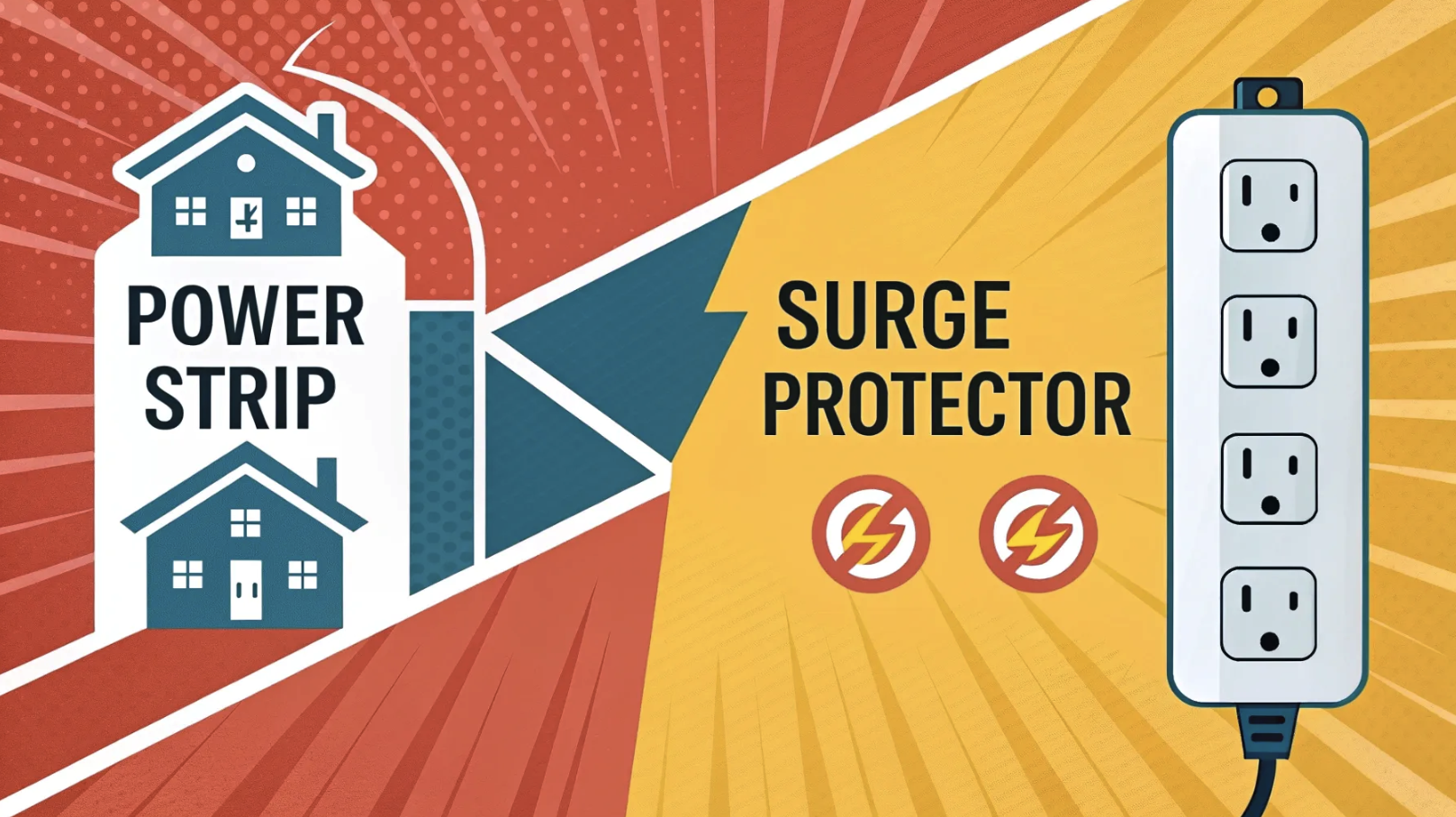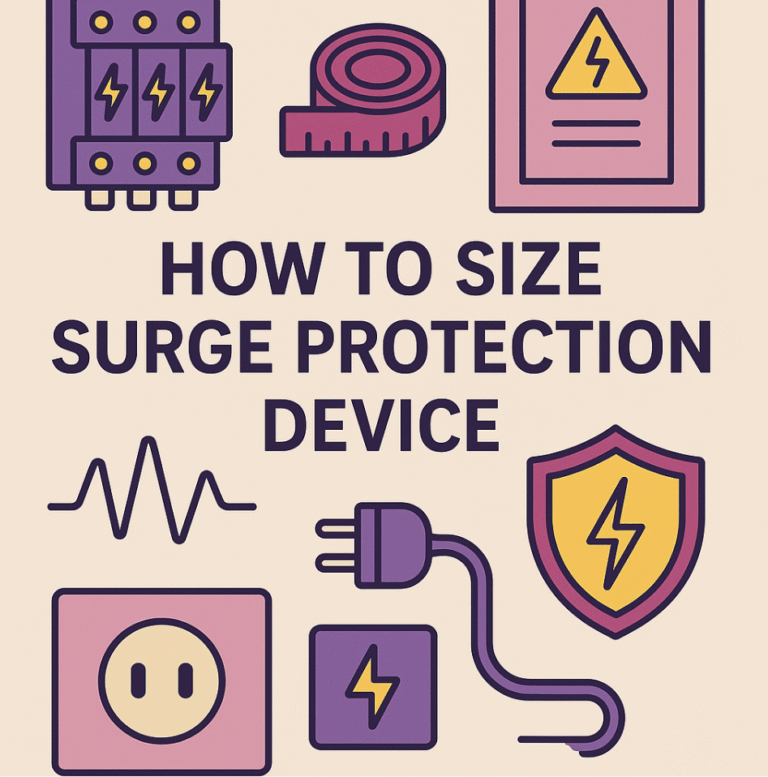Surge Protector vs Power Strip: What Makes Surge Protectors Superior

Have you ever wondered if your devices are truly safe from power surges? Many people assume a power strip is enough, but that’s not true. A power strip simply adds more outlets, while a comparison between a surge protector and a power strip reveals that a surge protector shields your electronics from dangerous voltage spikes.
A significant number of equipment failures occur due to power surges, with a 78% of equipment failures within five years happening within the first five years. This poses a substantial threat to your expensive devices. A common misconception – that all power strips offer surge protection – can lead to financial losses. Knowing the difference between a surge protector and a power strip is key to safeguarding your electronics and avoiding costly repairs.
Surge Protectors Outperform Power Strips in Safeguarding Electronics
When protecting your valuable devices, a surge protector is more reliable than a power strip. Here are the key benefits:
- Protection against power surges: Absorbs and redirects excess energy, safeguarding devices from damage.
- Enhanced safety: Prevents electrical fires by blocking or diffusing voltage spikes.
- Cost-effectiveness: Avoids costly repairs or replacements by protecting devices.
- Peace of mind: Provides confidence in device protection and long-term reliability.
Power Strip: Definition, Uses, and Limitations
What Is a Power Strip?
A power strip is a handy device that lets you plug multiple electronics into a single wall outlet. It is a handy device that lets you plug multiple electronics into a single wall outlet. It’s essentially a block of electrical sockets connected to a flexible cable. This setup is perfect for areas where outlets are limited. Some power strips even come with built-in circuit breakers to add a layer of safety.
However, it’s important to note that a power strip doesn’t offer protection against power surges. Unlike surge protector power strips, it simply extends your power capabilities, which shields your devices from voltage spikes.
Common Uses of Power Strips
You’ve probably seen power strips in action at home or work. They’re great for powering multiple low-energy devices like lamps, chargers, and small appliances. Many use them in entertainment centers to connect TVs, gaming consoles, and sound systems. They’re also popular in offices, where computers, printers, and other equipment need to share a single outlet. Power strips are convenient when you need more outlets, but they’re not designed for heavy-duty use.
Limitations of Power Strips
Lack of Surge Protection
One major drawback of a power strip is its inability to protect your devices from power surges. A sudden voltage spike can damage or destroy your electronics, and a basic power strip won’t stop it. If you’re using expensive gadgets like computers or home theater systems, relying on a power strip alone puts them at risk. This is where surge protectors come in—they’re specifically designed to handle these situations.
Safety Concerns with Overloading
Overloading a power strip is a common mistake that can lead to serious safety hazards. Plugging in too many high-energy devices generates heat, which can cause electrical fires. Did you know that daisy-chaining power strips (plugging one into another) is one of the leading causes of overloads?
Other risky behaviors include using damaged power strips or connecting devices like curling irons that exceed the strip’s capacity. To stay safe, always check the load limit of your power strip and avoid overloading it.
Safety Tip: Choose power strips with a built-in trip mechanism to prevent overheating and reduce fire risks.
Surge Protector: Features and Importance
What Is a Surge Protector?
Surge protectors protect electronic devices from power surges. Unlike power strips, they have components that absorb and redirect excessive voltage, shielding devices from lightning strikes or electrical surges. They serve as a barrier between sensitive electronics and power supply fluctuations.
How Surge Protectors Work
Mechanism of Diverting Excess Voltage
Surge protectors use advanced components to handle excess voltage. The most important part is the Metal Oxide Varistor (MOV). This clever component adjusts its resistance based on voltage levels. When a surge occurs, the MOV absorbs the extra energy and safely redirects it away from your devices.
Some surge protectors also include Gas Discharge Tubes (GDTs), which create a path for large surges to flow directly to the ground. These mechanisms ensure your electronics stay safe, even during severe power fluctuations.
Importance of Joule Ratings
Joule ratings are a key factor when choosing a surge protector. They tell you how much energy the device can absorb before it stops working. A higher joule rating means better protection.
For example, a surge protector with 1,000 joules can handle more surges than one with 400 joules. Keep in mind that each surge reduces the joules available, so it’s smart to replace your surge protector once it’s depleted.
Key Features of Surge Protectors
Indicator Lights
Ever wondered if your surge protector is still working? Indicator lights make it easy to check. These lights show whether the device is actively providing surge protection. If the light goes out, it’s time to replace the unit.
Built-in Circuit Breakers
Built-in circuit breakers add an extra layer of safety. They automatically shut off power if the surge protector overheats or becomes overloaded. This feature protects your devices and reduces the risk of electrical fires.
Why Surge Protectors Are Essential
Protection Against Power Surges
Power surges can strike when you least expect them. They happen during lightning storms, utility grid issues, or even when large appliances like air conditioners cycle on and off. These sudden voltage spikes can wreak havoc on your electronics. Without proper protection, your devices could suffer irreversible damage.
That’s where a surge protector steps in. It acts as a barrier, absorbing the excess energy and keeping your gadgets safe.
Think about your home office setup. Your computer, monitor, and printer are all plugged in and working perfectly. Now, imagine a power surge hitting your area. Without a surge protector, that spike could fry your equipment in seconds. A single surge can cost you hundreds—or even thousands—of dollars in repairs or replacements.
Surge protectors don’t just protect against catastrophic events like lightning strikes. They also handle smaller, everyday surges that slowly degrade your devices over time. By using one, you’re not just protecting your electronics from a single event—you’re extending their lifespan.
Safeguarding Expensive Electronics
Your electronics are more than just tools—they’re investments. Whether it’s your 4K TV, gaming console, or high-end sound system, these devices aren’t cheap. Safeguarding sensitive electronics should be a top priority, especially when you’ve spent so much on them.
A surge protector ensures your valuable gadgets stay safe, no matter what. It’s like having an insurance policy for your electronics.
For example, if you own a smart home system, a power surge could disrupt functionality or render it useless. Replacing those components could cost a fortune.
Using a surge protector gives you peace of mind. You can plug in your devices and trust they’re shielded from unexpected voltage spikes. It’s a small investment that pays off big in the long run. Plus, many surge protectors come with warranties that cover your devices if they fail. That’s added reassurance you can count on.
3 Recommended Surge Protectors
Belkin BP11223008 – 4320 Joules of Protection
- Multi-outlet surge protection: 12 AC outlets with surge protection to charge and power multiple devices at once.
- High joule surge protection: 4,320 joules of protection against overcurrent and overload to safeguard devices and appliances.
- Advanced safety features: 8-point safety system including protection from over temperature, overcurrent, overload, short circuit, and clamping.
- Rotating outlets for organization: 8 rotating outlets to fit larger power adapters and keep cords organized.
- UL safety certification and warranty: UL safety certification and a 2-year warranty, backed by a $300,000 Connected Equipment Warranty.
Tripp Lite TLP1208SAT – 2880 Joules of Protection
- Comprehensive surge protection: 12 outlets with surge protection, plus built-in protection for tel/modem, coax, and Ethernet connections.
- High joule surge protection: 2880 joules of surge protection to safeguard equipment against power surges.
- Advanced safety features: Automatic shutoff when protection circuit is compromised, and diagnostic LEDs to confirm grounding and protection.
- Convenient design: Right-angle plug and 8-foot AC power cord for flexible placement, with keyhole slots for wall mounting.
- Lifetime warranty and insurance: Lifetime Limited Warranty and $250,000 Ultimate Lifetime Insurance to cover connected equipment damaged by power surges.
APC P11U2 – 2880 Joules of Protection
- 11 outlet surge protection: 11 outlets to protect multiple devices from power surges.
- USB charging ports: 2 USB ports providing 2.4Amps of charging power for mobile devices.
- High joule surge protection: 2880 Joules surge protection energy rating to safeguard equipment.
- Space-saving design: 8-foot power cord with a flat end 90-degree space-saving plug.
- Lifetime warranty and equipment protection: Lifetime warranty and $250,000 connected equipment protection policy to cover damaged equipment.
Surge Protector vs Power Strip: Key Comparisons
Protection Levels
Surge Protectors vs. Basic Power Strips
When it comes to the level of protection, the difference between a surge protector and a power strip is night and day. A power strip simply provides extra outlets, which is handy but doesn’t offer any surge protection. This means your devices remain vulnerable to sudden voltage spikes.
On the other hand, a surge protector is designed to shield your electronics from these unpredictable surges. It absorbs and redirects excess energy, keeping your gadgets safe.
Surge protectors also come with a joule rating, which tells you how much energy they can handle before they stop working. Power strips lack this feature entirely. If you’re using expensive electronics like a gaming console or a home theater system, relying on a basic power strip is a risky move.
A surge protector provides multiple outlets and ensures your devices are protected from power spikes.
Cost Comparison
Initial Cost vs. Long-term Savings
At first glance, a power strip might seem like the cheaper option. Basic models are often priced lower because they don’t include any protective features. Surge protectors, while slightly pricier, offer much more value. Here’s a quick comparison:
|
Item |
Features |
|
|---|---|---|
|
Surge Protector |
$15-$20 |
Includes surge protection and joule ratings |
|
Power Strip |
$5-$10 |
Basic functionality, no surge protection |
While the upfront cost of a surge protector is higher, it saves you money in the long run. By preventing damage to your electronics, it reduces repair and replacement costs.
Plus, it extends the lifespan of your devices, ensuring they perform optimally for years. Think of it as an investment in your peace of mind.
Usage Scenarios
When to Use a Power Strip
A power strip works well for low-power devices that don’t need surge protection. For example, you can use one in your bedroom to plug in lamps, phone chargers, or alarm clocks. It’s also a good choice for small office equipment like staplers or fans. However, avoid using it for high-value electronics or appliances.
When to Use a Surge Protector
A surge protector is essential for sensitive and expensive electronics. Use one in your home office to protect your computer, printer, and monitor. It’s also a must-have for home theaters, where TVs, sound systems, and gaming consoles are at risk. In workshops, surge protectors safeguard tools from power surges, ensuring safety and longevity.
Large appliances like refrigerators provide an extra layer of protection against voltage spikes.
Benefits of Using a Surge Protector
Enhanced Safety
Preventing Electrical Fires
Electrical fires are a serious hazard, often caused by voltage spikes or overloaded circuits. Surge protectors play a vital role in preventing electrical fires by blocking or diffusing these dangerous spikes before they can cause overheating.
Did you know that over 3,300 house fires each year are linked to defective or improperly used electrical cords, including power strips?
Using a surge protector with an internal circuit breaker adds an extra layer of safety. It automatically shuts off power during overloads, reducing the risk of overheating. To ensure maximum safety, choose surge protectors that are UL or ETL approved and inspect them regularly for damage.
Protecting Against Voltage Spikes
Voltage spikes can strike at any time, whether from lightning storms or fluctuations in the electrical grid. These sudden surges can damage your devices or even render them useless. A surge protector acts as a shield, intercepting these spikes and redirecting the excess energy away from your electronics.
This protection prevents immediate damage and stops the gradual wear and tear spikes can cause over time. Look for a surge protector with a joule rating of 600 or higher for effective protection.
Cost-effectiveness
Avoiding Costly Repairs or Replacements
Replacing damaged electronics can be expensive. A single power surge could fry your computer, TV, or gaming console, leaving you with hefty repair bills. Surge protectors save you money by preventing this damage in the first place. They act as a small investment that protects your larger, more expensive investments.
Plus, many surge protectors come with warranties that cover your devices if they fail, giving you even more financial security.
Peace of Mind
Confidence in Device Protection
Knowing your devices are safe from unpredictable voltage spikes brings peace of mind. Whether it’s your home office setup or your entertainment system, you can trust that a surge protector is working behind the scenes to keep everything running smoothly. You won’t have to worry about sudden surges disrupting your day or damaging your valuable electronics.
Long-term Reliability
Surge protectors don’t just protect your devices—they extend their lifespan. By intercepting harmful spikes, they prevent the internal components of your electronics from degrading over time. To ensure your surge protector remains reliable, check its indicator lights regularly and replace it every two to three years or after a major surge event. This simple habit keeps your devices protected for the long haul.
Surge protectors are the clear winner when it comes to protecting your electronics. They don’t just add outlets—they shield your devices from harmful voltage spikes. Here’s why you should consider one:
-
Protect your valuable electronics like computers and TVs from destructive power surges.
-
Save money by avoiding costly repairs or replacements.
-
Extend the lifespan of your devices by preventing gradual damage.
-
Stay safe with built-in features that reduce fire risks.
Investing in a surge protector isn’t just smart—it’s essential. You’ll enjoy peace of mind knowing your devices are safe and performing at their best.






